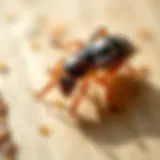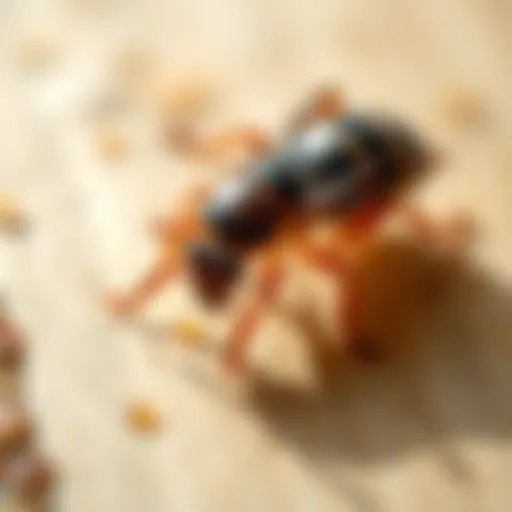The Most Effective Carpenter Bee Killer Sprays
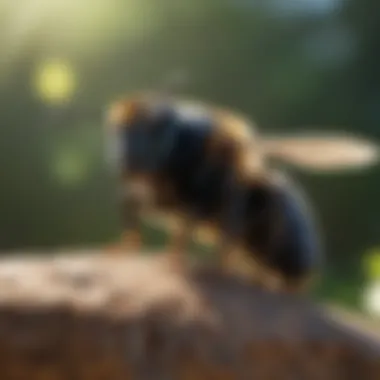

Intro
Carpenter bees can turn a charming summer afternoon into a contractor’s nightmare. Unlike their more docile bumblebee cousins, carpenter bees have a penchant for sinking their powerful jaws into untreated wood, leaving behind unsightly holes and a potential structural headache. They may not be your average pest, but their ability to damage wooden structures demands attention, especially from homeowners keen on preserving their properties.
In this comprehensive article, we delve into the realm of carpenter bee killer sprays, discussing not just efficacy but the hidden nuances of their ingredients and applications. We talk candidly about safety, prevention strategies, and even natural alternatives for those who'd rather not spray harsh chemicals. This guide is designed to enlighten homeowners, including housewives and DIY enthusiasts alike, equipping them with the knowledge to combat these buzzing marauders without breaking a sweat or a bank account.
Pest Identification
Detailed Descriptions of Common Pests
Understanding who your enemy is crucial before you can bring out the big guns. Carpenter bees, often mistaken for bumblebees, are notable for their shiny, hairless abdomens. They measure about an inch in length, with males usually exhibiting a yellow face and females taking on a more subdued look.
Unlike ordinary bees, carpenter bees are solitary creatures, preferring to burrow into wood rather than live in colonies. Their nesting behavior leads to significant damage if left unchecked, as they tunnel into eaves, decks, and fences.
Signs and Symptoms of Infestations
Identifying an infestation is usually simpler than one might think. Keep an eye out for:
- Holes in Wood: Often the most obvious sign; the holes can be quite round and are approximately the size of a dime.
- Sawdust Piles: Look for fine wood shavings that accumulate below their entry holes. This is a telltale sign of carpenter bees at work.
- Buzzing Sounds: Sometimes, you might hear the dull thrum of their flight as they busy themselves with drilling tunnels.
- Presence of Males: Male carpenter bees are particularly aggressive and will hover around their nesting spots, although they cannot sting.
As you scrutinize your outdoor areas, not only will you stay proactive, but you also will retain peace of mind knowing what you're up against.
Prevention Strategies
Home Maintenance Tips for Pest Prevention
Taking preventive measures is always better than dealing with pests after they’ve made themselves at home. Here are some practical steps:
- Seal Cracks and Holes: Ensure that any existing damage on wooden surfaces is properly filled and painted. Carpenter bees are less likely to burrow into treated or sealed wood.
- Opt for Hardwoods: If you are in the market for new wooden structures or renovations, consider using hardwoods. They are less appealing to carpenter bees than softwoods.
- Maintain Yard Cleanliness: Keep exterior areas tidy to reduce potential nesting sites, such as old wooden furniture or debris.
Natural Deterrents and Barriers
If the idea of using sprays raises eyebrows, consider these natural deterrents:
- Citrus Oil: Spraying wood surfaces with a mixture of citrus oil and water can repel these bees effectively.
- Vinegar: A simple solution of vinegar and water can be sprayed around potential nesting sites.
- Essential Oils: Oils like peppermint and tea tree haven't just good scents; they are also disliked by carpenter bees.
These strategies can save a lot of grief down the line and help keep your property bee-free.
Treatment Options
Overview of Chemical vs. Natural Treatments
When it comes to treatments, choices abound. Chemical sprays usually provide immediate results but can come with environmental concerns. In contrast, natural treatments may require repetitive applications but pose less risk to wildlife and surrounding plants.
Step-by-Step Guides for DIY Treatments
For those with a proactive mindset, here's how you can tackle the carpenter bee hassle:
- Identify the Nesting Site: Check for holes and the presence of sawdust.
- Choose Your Spray: Depending on your comfort level, select either a chemical spray or a home remedy.
- Apply During Late Evening: Carpenter bees are less active during late evening, making it an ideal time for application.
- Seal Up After Treatment: Once the bees are dealt with, use caulk or wood filler to seal entry points.
Attacking the problem head-on—with the right tools and know-how—ensures you're reclaiming your space from these buzzing invaders.
Understanding Carpenter Bees
Understanding carpenter bees is crucial for any homeowner wanting to protect their property. These insects are known to cause damage to wooden structures due to their nesting habits. By grasping the biology and behavior of carpenter bees, you can take proactive steps towards effective management. It’s not just about elimination; it's about ensuring your home remains intact.
Biology and Behavior
Carpenter bees exhibit fascinating characteristics that set them apart from other bee species. Unlike honeybees, the males are devoid of stingers, while females can sting but usually only do so when provoked. They are often mistaken for bumblebees because of their similar size and coloration, though carpenter bees have a more shiny, hairless abdomen compared to the fuzzy appearance of bumblebees.
These bees are solitary in nature. While bumblebees live in colonies, carpenter bees prefer to nest alone. They bore holes into wood, creating tunnels which serve as their nesting sites. One female can create multiple tunnels, and she will lay eggs in chambers at the end of each tunnel. This behavior is what makes them infamous for damaging wooden structures, as they can weaken the integrity over time.
Habitat and Nesting Patterns
Carpenter bees are not picky about their nesting accommodations, often seeking out untreated wood that is weathered or soft. Common places you'll find them include:
- Wooden decks and patios
- Eaves and fascia boards
- Fence posts
- Unpainted wood siding
The physical structure of the nesting site influences how deeply they bore into the wood. In the early spring, females emerge from hibernation, seeking favorable spots for nesting. The choice of location is a critical phase in their life cycle. After the female has set up her home, she will lay her eggs and supply them with pollen and nectar before sealing the chamber.


Understanding these patterns can help you identify potential problem areas around your home. If you spot round holes that seem to be almost rhythmic in spacing, it’s likely a sign of carpenter bee activity. Early detection is key to preventing more extensive damage.
"Knowing the habits of carpenter bees can lead to effective preventive actions, keeping your home safe from these stubborn pests."
In summary, being aware of carpenter bees’ biology and habitat is the first step in effective control. This knowledge not only informs the right type of carpenter bee killer sprays to use but also aids in making informed decisions that align with your efforts in maintaining your home. Prioritizing this understanding can lead to a more harmonious coexistence with the natural world while safeguarding your property.
The Need for Carpenter Bee Control
Carpenter bees, while generally seen as harmless pollinators, can cause significant damage to homes and structures. Homeowners often underestimate the impact these bees can have until they find themselves facing costly repairs. Understanding the necessity for effective carpenter bee control helps in safeguarding not just your property but also your peace of mind.
Impact on Structures and Property
Carpenter bees are notorious for boring into wood to create their nests. They prefer softwoods, such as pine and cedar, which means that your beautiful deck or wooden siding is prime real estate for these pests. The holes, often perfectly round, can lead to extensive damage, making your structures susceptible to rot and other infestations. Here are some of the main concerns related to their impact:
- Structural Stability: Over time, the consistent boring and nesting can compromise the integrity of your wooden structures.
- Aesthetic Damage: A home that is peppered with holes and the telltale signs of wear often loses its curb appeal, which can be especially disheartening if you take pride in home improvement.
- Secondary Infestations: Damaged wood can attract other pests, such as termites, leading to a double whammy of trouble.
So, understanding how and where these bees set up shop is key to preventing them from wreaking havoc.
When Infestations Occur
Timing is crucial in handling carpenter bee infestations. They typically become active in spring, often coinciding with warmer weather. Female carpenter bees emerge first, looking for suitable spots to nest. Here’s what to keep an eye on:
- March to May: This period marks the peak activity for carpenter bees. Active drilling sounds are commonly heard around this time as females start creating nests. Early detection during these months can prevent a small problem from turning into an outright infestation.
- Signs of Infestation: Look for the presence of holes, sawdust on the ground, and the buzzing sound of bees around your home. These are clear indicators that your property may have been colonized.
"Understanding the lifecycle and habits of carpenter bees not only equips you to deal with current infestations but also prepares you to implement preventative measures for the future."
Ignorance is not bliss when it comes to carpenter bees. Recognizing the signs of their activity and the potential for damage will allow you to take the necessary steps to protect your investment.
By addressing the needs for control, homeowners can save themselves the headaches associated with significant repairs and unwanted pests. The next step is understanding how to effectively select and apply appropriate carpenter bee killer sprays, leading to better defense against these unwelcome guests.
Selecting the Best Carpenter Bee Killer Spray
Choosing the right carpenter bee killer spray is essential to effectively manage these pests. With various options on the market, understanding which one suits your needs involves more than just a glance at the label. It requires consideration of efficacy, safety, and environmental impact, along with your specific infestation situation. Selecting the best spray ensures not only the swift elimination of carpenter bees but also the protection of your home and family.
Types of Sprays Available
Carpenter bee killer sprays come in several formulations, each designed to tackle the problem from different angles.
- Aerosol Sprays: These are ready-to-use and offer a quick solution. The spray can reach high or hard-to-reach areas, ideal for those pesky nests in eaves or rafters. Application is straightforward, making them a go-to choice for many homeowners.
- Concentrated Sprays: If you’re looking at larger areas or have extensive infestations, concentrated formulations might be your best bet. They require mixing prior to use, which allows for customizable application based on the severity of the problem.
- Residual Sprays: These linger longer on surfaces, creating a barrier that can deter carpenter bees after the initial application. Ideal for preventing future infestations, they often target the routes bees take as they look for nesting sites.
- Organic Sprays: For the eco-conscious, there are organic alternatives that use plant-based ingredients to repel or kill bees. While perhaps less potent than chemical options, they provide an effective solution without compromising your garden's ecosystem.
Understanding the differences between these types can help you make an informed decision. When selecting a spray, consider your preference for convenience versus on-the-ground effectiveness.
Active Ingredients to Look For
Ingredients in pest control products often dictate their efficiency. When shopping for a carpenter bee killer, keep an eye out for these active components:
- Permethrin: This is a synthetic pyrethroid, commonly found in sprays due to its fast-acting capabilities. It targets the nervous system of bees, leading to a swift demise.
- Bifenthrin: Another chemical from the pyrethroid family, bifenthrin has a reputation for its residual effects, making it useful in retaining efficacy over time.
- Neem Oil: Derived from the seeds of the neem tree, this natural extract disrupts the life cycle of bees, repelling them effectively while being safer for the environment.
- Insect Growth Regulators (IGRs): These do not kill bees outright but prevent them from maturing, effectively curtailing populations over time.
Carefully reading labels will provide valuable insights into what you are using both in terms of effectiveness and potential exposure risks. The right active ingredients ensure you are equipped for a successful battle.
Brand Comparisons and Reviews
A plethora of brands offer carpenter bee killer sprays, each touting their own unique selling points. Here’s a breakdown of a few notable contenders based on user feedback and expert evaluations:
- Ortho Home Defense Insect Killer: Many users praise its long-lasting formula that is also effective against other pests. It combines fast action with a persistent residual impact.
- Spectracide carpenter bee killer: This spray has received accolades for its targeted application and effectiveness, particularly for hard-to-reach nests. Customers appreciate its ease of use.
- EcoSMART Organic Insect Killer: If you’re leaning towards eco-friendly options, this brand stands out. Reviews indicate its effectiveness against carpenter bees without the side effects that come from harsher chemicals.
- Hot Shot Bed Bug and Flea Killer: Though primarily marketed for bed bugs, some consumers have reported success in targeting carpenter bees, showcasing its versatility.
Comparing brand performance against your specific needs aids in narrowing down the plethora of choices available. Make sure to peruse reviews and consider experiences shared by other homeowners to find the most effective product for your situation.
Choosing wisely when it comes to carpenter bee killer sprays means safeguarding your home and family while maintaining an effective approach to pest control.
How to Apply Carpenter Bee Killer Spray Effectively
Applying carpenter bee killer spray is both an art and a science. Its importance in this article lies in helping homeowners deal with these wood-boring pests in a safe and efficient manner. Understanding how to apply these sprays effectively minimizes damage to your property while also safeguarding your home environment—protecting pets and children from toxic exposure.
Preparation and Precautions
Before you grab that spray can and start spraying like it’s the Fourth of July, you need to get your ducks in a row. Preparation step is crucial.
- Read the Label: Always start by reading the instructions on the label. Different sprays have different requirements and instructions, and you don’t want to miss any crucial information.
- Wearing Protective Gear: It’s a good idea to don gloves, a mask, and safety glasses. While you might not be in a full hazmat suit, protecting yourself from potentially harmful chemicals is wise.
- Choose the Right Time: Late evening or early morning is typically best for application. Carpenter bees are less active during these times, reducing the likelihood of you getting stung.
- Wind Conditions: Make sure there’s minimal wind. This ensures the spray goes where you want it to, instead of drifting to your garden or neighbors—nobody wants a bee incident with the neighbors.
Step-by-Step Application Process
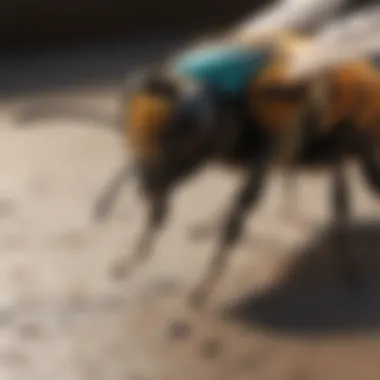

Once you are set up and ready, here’s how to tackle the application like a pro:
- Identify the Infestation: Begin by locating the nests of the carpenter bees. They often bore into wood structures, making small round holes.
- Prepare the Spray: Shake the can or bottle as instructed. This ensures the chemicals mix properly and enhances effectiveness.
- Aim for the Nest: Position the nozzle towards the entrance of the nest. Making sure to hold it steady and a few inches away from the hole is great for preventing overspray.
- Spray Generously: Apply a good amount of spray into the entrance, ensuring it reaches those lurking indoor bees. You want to saturate the area, but not to the extent that it runs down the surface.
- Take a Step Back: After spraying, back away and monitor the area for a few minutes. Keeping your distance will protect you from any unexpected bee activity.
Post-Application Care
You’re nearly done, but don’t forget the follow-up. How you care for the area after application can make a considerable impact on efficacy.
- Disposing of Materials: Dispose of any remaining spray cans or connected materials properly, to avoid deterioration and potential hazards to others.
- Monitor Behavior: Check the treated area within a few days for signs of bee activity. If the bees are still buzzing around like it’s a party, you may need to reapply or consider more drastic measures.
- Cleaning Up: Once you are sure the bees are gone, consider cleaning the area if necessary. This includes sealing any holes and repainting or treating the wood again to prevent any future infestations.
Doing things by the book not only yields results but also keeps your home and loved ones safe. A bit of pre-planning goes a long way.
Using sprays effectively takes care, attention to detail, and patience. The combination of proper preparation, execution, and follow-up ensures that your battle against carpenter bees is both effective and safe.
Safety Considerations
When dealing with carpenter bee killer sprays, safety is a paramount concern that homeowners must prioritize. These sprays, while effective in curbing these pesky critters, come with considerations that demand attention. Ignoring safety precautions can lead to unintended consequences, not only for the individuals using the products but also for pets in the vicinity and the environment as a whole. By understanding the nuances of safety regarding these sprays, you can use them effectively without compromising well-being.
Protecting Humans and Pets
One of the first and foremost aspects of safety is keeping humans and pets safe when applying carpenter bee killer sprays.
- Read Labels Carefully: Before starting, familiarize yourself with the product's instruction manual. Different sprays have unique requirements and guidelines.
- Use Personal Protective Equipment (PPE): Equip yourself with gloves, goggles, and a mask during application. This minimizes direct exposure to potential toxins in the spray.
- Apply at a Safe Distance: Maintain a safe distance from areas where people or pets usually roam. This way, you can prevent any accidental inhalation or contact with skin. Ideally, apply the spray early in the morning or late in the evening when bees are less active, helping to further reduce risk.
- Secure Pets: If you have pets, it’s wise to keep them indoors or away from the application area until the spray has dried completely.
Following these measures not only protects you and your loved ones but also ensures that the treatment is effective without unintended harm.
Environmental Impact of Sprays
Many homeowners are increasingly conscious of the impact their choices have on the environment. Carpenter bee killer sprays, often critiqued for their chemical compositions, should hence be chosen with sustainability in mind.
- Choose Eco-friendly Options: Many brands offer sprays with natural ingredients that are less harmful to beneficial insects and the environment. Look for those listed as “biodegradable” or “non-toxic.”
- Understand the Chemical Components: Common active ingredients like pyrethroids can be harmful to aquatic life and beneficial insects. Investigate the active compounds in your chosen product and choose environmentally friendly options when possible.
- Follow Local Regulations: In certain areas, there may be specific regulations around the use of pesticides, particularly near water bodies or among sensitive ecosystems. Being aware of these guidelines helps to keep our neighborhoods safe and intact.
- APPLY responsibly: Avoid spraying on windy days to prevent drift, which can affect non-target areas.
“Choosing the right product and applying it responsibly can benefit not just your property, but the larger ecosystem as well.”
By considering these elements, you can ensure that your quest for pest control doesn’t come at the cost of safety—both for yourself and the planet.
Alternative Treatments for Carpenter Bee Infestations
When it comes to managing those pesky carpenter bees, it's crucial to explore alternative treatments. Not only can these methods be effective, but they also offer options that may align better with those looking for non-toxic or less harmful strategies. By diving into this approach, you’re not just combating an infestation; you’re also engaging in environmentally conscious practices. Many homeowners are gravitating towards these alternative solutions as a way to foster a healthier living space for their families and pets without compromising the effectiveness of pest management.
Natural and Organic Options
For individuals who are hesitant about using chemical sprays, natural and organic methods present a valid route. These options can mitigate the presence of carpenter bees while prioritizing safety and ecological responsibility.
One effective method involves the use of essential oils, such as peppermint, tea tree oil, or clove oil. The potent scents of these oils are overwhelming for carpenter bees, prompting them to steer clear from treated areas. Applying these oils in concentrated forms can serve as a formidable repellent. Mixing a few drops of essential oil with water in a spray bottle can lead to a simple yet powerful deterrent. Spray it around potential nesting sites or even on wood surfaces that might attract these bees. Here are some tips pertaining to organic methods:
- Planting Repellent Flowers: Certain plants such as marigolds or geraniums can help keep carpenter bees away. These flowers not only beautify your garden but also act as natural repellents.
- Vinegar Solutions: A mixture of vinegar and water can be sprayed on infested areas. Bees dislike the pungent odor, which encourages them to find a new home elsewhere.
- Citrus-Based Repellents: Rubbing citrus peels or using lemon and orange juice mixed with water can have a similar repellent effect. The aroma is less offensive to humans but repels bees effectively.
Implementing these natural treatments can bring peace of mind while addressing an infestation, making it a preferred choice for some homeowners.
Physical Barriers and Traps
Physical barriers and traps are another practical way to confront carpenter bee issues. Employing these methods means you are providing direct, albeit non-lethal, alternatives to deal with these insects effectively.
Setting up barriers like wooden bee traps or utilizing meshes can significantly reduce the chances of bees nesting in your property. Here are some efficient strategies and alternatives to consider:
- Wooden Traps: Crafted simply from wood, these traps utilize light-colored materials that attract carpenter bees. Once they enter, however, they find it difficult to leave. They can be purchased online or made at home using tutorials found on various DIY platforms.
- Nail Traps: A handy trick is to use a small, dark-colored container filled with soapy water. Hanging this near areas where you've seen frequent bee activity lures them in and prevents their escape.
- Mesh Screens: Install mesh barriers in areas that are high-risk for nests without obstructing airflow. Even covering exposed wood with mesh can help deter nesting activity in those spaces.
Using these approaches not only aids in controlling carpenter bee populations but also encourages respectful coexistence with nature. A well-planned strategy for physical barriers and traps can ultimately lead to a balanced home environment.
By opting for alternative treatments such as natural solutions and physical barriers, homeowners show a commitment to sustainable practices while still effectively managing carpenter bee infestations.
Preventative Measures to Avoid Future Infestations
Avoiding carpenter bee infestations in the first place is often less troublesome than dealing with them after they’ve made a home in your property. A little foresight can save both time and money, as well as prevent damage to your home. In this section, we'll delve into essential strategies and best practices that can keep these buzzing pests at bay.
Home Maintenance and Repairs
Carpenter bees have a knack for finding soft, untreated wood to burrow into, so maintaining your home's structure is a vital step in preventative action. Here are several key elements to consider:
- Inspect Wooden Structures Regularly
Look for signs of wear and tear in wooden areas. Peeling paint or bare wood can be an invitation for carpenter bees. Even small openings can serve as ideal entry points. - Seal Cracks and Holes
Use caulk or wood filler to seal any cracks, especially around windows, doors, and other joints. This method not only keeps carpenter bees out but also enhances your home's energy efficiency. - Stain or Paint Wood
Treat all wooden surfaces with a proper sealant, stain, or paint. This creates a barrier and eliminates the soft texture that these pests find appealing. A good quality exterior paint not only looks appealing but also protects wood from moisture and pests.
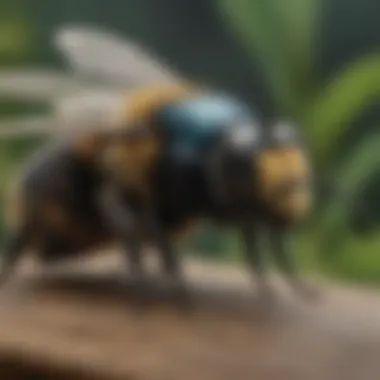

"Prevention is better than cure, especially when it comes to woodwork and pest control."
- Replace Damaged Wood
If you notice wood that has already been compromised, replace it promptly. New, untreated wood can quickly become a nest site if left unattended. Make sure to dispose of any old wood safely so that it cannot be reused by the bees.
These actions go a long way in making your property less attractive to carpenter bees, providing a solid foundation for a pest-free environment.
Landscaping Tips
Landscaping plays a subtle yet critical role in pest management. Making your yard less inviting to carpenter bees includes several practical considerations:
- Keep Flowers Away from Your Home
While bees support healthy ecosystems, having abundant flowering plants too close to your home can attract them. If you love blooming flowers, consider planting them further away from the house. - Opt for Non-Wooden Materials
If you are building structures like fences or decks, consider using materials that are less appealing to carpenter bees. For example, composites or metal are generally less attractive than natural wood. - Plant Carpenter Bee Repellent Species
Some plants deter carpenter bees. Consider growing herbs like mint or lavender, which bees tend to avoid. Not only do they smell good, but they'll also keep certain pests at bay.
Maintaining your home and carefully considering your landscaping can significantly reduce the risk of future carpenter bee infestations. While you can't control every aspect of nature, these proactive approaches will help fortify your defenses against these determined little buzzers.
Debunking Common Myths about Carpenter Bees
Understanding the myths surrounding carpenter bees is crucial for effective pest management. By separating fact from fiction, homeowners can make informed decisions when it comes to dealing with these bees. Selection of treatments, preventive measures, and management strategies all hinge on the clarity provided by debunking these myths. Furthermore, recognizing the true nature of carpenter bees can foster a healthier relationship between humans and these critical pollinators.
Myth: Carpenter Bees Are Just Large Bumblebees
Many people glance at a carpenter bee and think it resembles a bumblebee but larger. Upon a closer look, the distinctions are clear. While they share the same family, carpenter bees have a shiny, hairless abdomen, unlike the fuzzy appearance of bumblebees. This difference is more than skin deep; it speaks to their behavior and ecological roles.
Carpenter bees are solitary creatures who bore into wood to create their nests, leading to misunderstandings about their intentions. Most people fear for their properties and automatically assume aggression, which seldom occurs. They are typically non-aggressive unless provoked. A proper understanding can help diffuse fears that arise from mere appearance.
Myth: All Bees Are Harmful
Not all bees are out to get you. In fact, carpenter bees contribute positively to our ecosystems as pollinators. The fear stems largely from a lack of knowledge. Most homeowners will encounter anxiety when they notice these insects buzzing about their gardens. The truth is, carpenter bees are not inherently harmful; their nesting behaviors may cause structural concerns, but their presence in flowers is beneficial. Educating yourself on their role in nature can shift the perspective from fear to appreciation.
"Bees play a key role in maintaining biodiversity. They are crucial for food production and ecosystem health."
Myth: Once They Nest, They Never Leave
One of the common misconceptions is that once carpenter bees have established their nests, they become permanent residents. While it's true that they return to the same nesting sites year after year, they do not result in unyielding infestations. More often than not, they may vacate if the conditions change or if the wood deteriorates. Understanding this provides homeowners with more room to be proactive instead of reactive. Proper maintenance and occasional treatments can effectively deter their return.
Thus, addressing these myths allows homeowners to approach the issue with the right mindset and practical strategies. Handling carpenter bees and their nesting can be approached thoughtfully and successfully when one has the right information.
Professional Pest Control Options
When dealing with carpenter bee infestations, sometimes the do-it-yourself solutions just don’t cut it. This section dives into the importance of professional pest control options, explaining why enlisting the help of experts can be a game changer for homeowners.
Carpenter bees might seem like just another pest, but they can wreak havoc on homes if left unattended. These insects can tunnel through wood, leading to structural weaknesses in porches, eaves, and wooden beams. Thus, knowing when and how to seek professional help can save you both time and money in the long run.
When to Seek Professional Help
Recognizing the red flags that signal it's time to call in the pros is crucial. Here are a few indicators that suggest you should look for professional pest control:
- Severe Infestation: If you've noticed numerous carpenter bee holes or a significant number of bees flying around, this is a clear sign that they’ve taken up residence.
- Persistent Return: If you’ve tried DIY sprays and methods without success, it might be time to bow out. These pests can be remarkably resilient, returning year after year if conditions favor them.
- Structural Damage: Signs of wood damage or powdery residue under existing nests can indicate deeper infiltration. Structural integrity of your home is paramount, and professionals can assess the extent of the damage.
- Health Concerns: For those with allergies or respiratory issues, confronting an active nest can pose health risks. It's always best to prioritize safety in such cases.
Identifying when to seek help involves a bit of instinct, but also observation. Don’t wait until it’s too late.
What to Expect from Professional Services
Engaging a professional pest control service doesn’t just mean spraying some chemicals and walking away. Here’s a breakdown of what you can expect:
- Comprehensive Inspection: A qualified technician will perform a thorough inspection of your property, identifying not only visible nests but also potential breeding grounds.
- Tailored Treatment Plans: Based on their findings, they will develop a treatment plan tailored to the specific type and scale of your infestation. This could include various methods that the average homeowner might not have access to.
- Application of High-Quality Sprays: Professionals often use advanced products that can be more effective than standard over-the-counter sprays, focusing on the active ingredients that combat young larvae.
- Safe Extermination Practices: Reputable companies will emphasize safety, ensuring that the products used are effective while minimizing risk to humans and pets.
- Follow-Up Services: After the initial treatment, many services offer follow-up visits to ensure the bees don't return, reinforcing any barriers that have been put in place.
"An ounce of prevention is worth a pound of cure" – Benjamin Franklin. When it comes to carpenter bees, this couldn't be truer.
In short, high-quality professional pest control can provide peace of mind, especially when these bees threaten the health and safety of your home.
Culmination
In summing up the comprehensive guide on carpenter bee killer sprays, it's crucial to underscore the significance of understanding both the threats posed by carpenter bees and the effective means to manage them. By investigating the various options available, we aim to arm homeowners with the knowledge they need to protect their properties without fuss.
Integrating this information empowers individuals to make informed decisions regarding pest control. The key here is to recognize that not all bee-infested areas require the same treatment. Each situation calls for a tailored approach, addressing factors such as the severity of the infestation, the environment, and the presence of pets and children.
"Knowledge is the first step in successful pest management."
By understanding the lifecycle and behavior of carpenter bees, selecting effective sprays, and practicing safety measures, individuals not only safeguard their homes but also contribute to a healthier ecosystem.
Recap of Key Points
- Carpenter bees, despite their similarities to bumblebees, can cause significant damage to wooden structures.
- Controlling these pests involves understanding their nesting habits and life cycle.
- Multiple sprays are available, each with specific active ingredients that have varying levels of effectiveness against carpenter bees.
- Application techniques play a critical role in the success of these sprays. Proper preparation can minimize risks to other wildlife.
- Environmental impact is a major consideration; therefore, alternative methods and organic solutions are worth exploring.
Final Recommendations
- Assess the Infestation: Before choosing a spray, evaluate the extent of the infestation. For minor issues, a less aggressive approach might suffic.
- Select the Right Product: Always refer to the active ingredients. Pyrethroids might be helpful, but some natural solutions can also prove effective if you prefer a non-toxic route.
- Follow Application Instructions: Read and adhere to the manufacturer's instructions. Often, the success lies in the details of the application process.
- Practice Preventative Maintenance: Beyond dealing with current infestations, regularly inspect your property and treat potential nesting areas.
- Consider Professional Help: If unsure, engaging professional pest control should not be overlooked. Their expertise ensures more effective solutions, especially for severe infestations.
